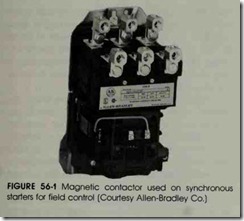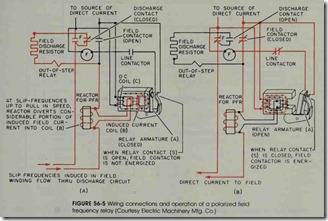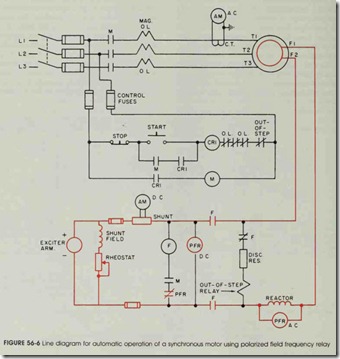Objectives
After studying this unit, the student will be able to:
• Describe how an out-of-step relay protects the starting winding of a synchronous motor
• Describe the action of a polarized field frequency relay in applying and removing de field excitation on a synchronous motor
• Connect synchronous motors and controllers which use out-of-step relays and polarized field frequency relays to achieve automatic motor synchronization
• Recommend troubleshooting solutions for problems
An automatic synchronous motor starter can be used with a synchronous motor to provide au tomatic control of the startup sequence. That is, the controller automatically sequences the opera tion of the motor so that the rotor field is synchro nized with the revolving magnetic field of the stator.
There are two basic methods of starting synchronous motors automatically. In the first method, full voltage is applied to the stator wind ing. In the second method, the starting voltage is reduced. A commonly used method of starting synchronous motors is the across-the-line connec tion. In this method, the stator of the synchronous motor is connected directly to the plant distribu tion system at full voltage. A magnetic starter is used in this method of starting.
A polarized field frequency relay can be used for the automatic application of field excitation to a synchronous motor.
ROTOR CONTROL EQUIPMENT
Field Contactor
The field contactor opens both lines to the source of excitation, figure 56-1. During starting, the contactor also provides a closed field circuit through a discharge resistor. A solenoid-operated field contactor is similar in appearance to the stan dard de contactor. However, for this de operated contactor, the center pole is normally closed. It is designed to provide a positive overlap between the normally closed contact and the two normally open contacts. This overlap is an important fea ture because it means that the field winding is never open. The field winding of the motor must always be short-circuited through a discharge re sistor or connected to the de line. The coil of the field contactor is operated from the same direct current source that provides excitation for the syn chronous motor field.
Out-of-Step Relay
The squirrel cage winding, or starting (amor tisseur) winding will not overheat if a synchronous motor starts, accelerates, and reaches synchronous speed within a time interval determined to be nor mal for the motor. In addition, the motor must continue to operate at synchronous speed. Under these conditions, adequate protection for the en tire motor is provided by three overload relays in the stator winding. The squirrel cage winding, however, is designed for starting only. If the mo tor operates at subsynchronous speed, the squirrel cage winding may overheat and be damaged. It is not unusual for some synchronous motors to with stand a maximum locked rotor interval of only five to seven seconds.
An out-of-step relay (OSR), figure 56-2, is provided on automatic synchronous starters to protect the starting winding. The normally closed contacts of the relay will open to de-energize the line contactor under the following conditions =
1. the motor does not accelerate and reach the synchronizing point after a preset time delay.
FIGURE 56-2 Out-of-step relay used on synchronous start ers (Courtesy Allen-Bradley Co.)
1. the motor does not return to a synchronized state after leaving it.
2. the amount of current induced in the field winding exceeds a value determined by the core setting of the out-of-step relay.
As a result, power is removed from the stator cir cuit before the motor overheats.
Polarized Field Frequency Relay
A synchronous motor is started by accelerat ing the motor to as high a speed as possible from the squirrel cage winding and then applying the de field excitation. The components responsible for correctly and dependably applying and remo v ing the field excitation are a polarized field fr e quency relay (PFR) and a reactor, figure 56-3.
The operation of the frequency relay is shown in figure 56-4. The magnetic core of the relay has a direct-current coil (C), an induced field-current coil (B), and a pivoted armature (A) to which con tact (S) is attached. Coil C is connected to the source of de excitation. This coil establishes a con stant magnetic flux in the relay core. This flux causes the relay to be polarized. Superimposed on this magnetic flux in the relay core is the alternat ing magnetic flux produced by the alternating in duced rotor field current flowing in coil B. The flux through armature A depends on the flux pro duced by ac coil B and de coil C. Coil B produces an alternating flux of equal positive and negative magnitude each half-cycle. Thus, the combined flux flowing through armature (A) is much larger when the flux from coil B opposes that from coil In figure 56-4(A), the flux from coil B opposes the flux from de coil C, resulting in a strong flux being forced through armature A of the relay. This condition is shown by the lower shaded loops of figure 56-4(C). One-half cycle later, the flux produced by coil B reverses and less flux flows through armature A. This is due to the fact that the flux from coil B no longer forces as inuch flux from coil C to take the longer path through arma ture A. The resultant flux is weak and is illus trated by the small, upper shaded loops of figure 56-4(C). The relay armature opens only during the period of the induced field current wave, which is represented by the small, upper loops of the relay armature flux.
As the motor reaches synchronous speed, the induced rotor field current in relay coil B de creases in amplitude. A value of relay armature flux (upper shaded loop) is reached at which the relay armature A no longer stays closed. The relay then opens to establish contact S. De excitation is then applied at the point indicated on the induced field current wave.
Excitation is applied in the direction shown by the arrow. The excitation is opposite in polarity to that of the induced field current at the point of application. This requirement is necessary to com pensate for the time needed to build up excitation. The time interval results from the magnetic inertia of the motor field winding. Because of the inertia, the de excitation does not become effective until the induced current reverses (point 0 on the wave) to the same polarity as the direct current.
The excitation continues to build up until the mo tor is synchronized as shown by point M on the curve.
Figure 56-5 indicates the normal operation of the frequency relay. De excitation is applied to the coil of the relay at the instant the synchronous mo tor is started. When the stator winding is ener gized, using either full voltage or reduced voltage methods, line current is allowed to flow through the three overload relays and the stator winding. Line frequency currents are induced in the two electrically independent circuits of the rotor: (1) the squirrel cage or starting windings and (2) the field windings. The current induced in the field windings flows through the reactor. This device shunts part of the current through the ac coil of the frequency relay, the coil of the out-of-step re lay, the field discharge resistor, and finally to the normally closed contact of the field contactor. The flux established in the frequency relay core pulls the armature against the spacer and opens the normally closed relay contacts, figure 56-5. As the motor accelerates to the synchronous speed, the frequency of the induced currents in the field windings diminishes. There is, however, sufficient magnetic flux in the relay core to hold the arma ture against the core. This flux is due to a consid erable amount of induced current forced through the ac coil of the frequency relay by the imped ance of the reactor at high slip frequency.
At the point where the motor reaches its syn chronizing speed (usually 92 to 97 percent of the synchronous speed) the frequency of the induced field current is at a very low value. The reactor impedance also is greatly reduced at this low fre quency. Thus, the amount of current shunted to the ac coil is reduced to the point where the resul tant core flux is no longer strong enough to hold the armature against the spacer. At the moment that the rotor speed and the frequency and polar ity of the induced currents are most favorable for synchronization, the armature is released, the relay contacts close, and the control circuit is com pleted to the operating coil of the field contactor . De excitation is applied to the motor field wind ing, figure 56-S(B). At the same time, the out-of step relay and discharge resistor are de-energized by the normally closed contacts of the field contactor.
An overload or voltage fluctuation may cause the motor to pull out of synchronism. In this case, a current at the slip frequency is induced in the field windings. Part of this current flows through the ac coil of the polarized field frequency relay, opens the relay contact, and removes the de field excitation. The motor automatically resynchron izes if the line voltage and load conditions return to normal within a preset time interval, and the motor has enough pull-in torque. However, if the overload and low-voltage conditions continue so that the motor cannot resynchronize, then either the out-of-step relay or the overload relays activate to protect the motor from overheating.
SUMMARY OF AUTOMATIC STARTER OPERATION
The line diagram in figure 56-6 shows the au tomatic operation of a synchronous motor. For starting, the motor field winding is connected through the normally closed power contact of the field contactor (F), the discharge resistor, the coil of the out-of-step relay, and the reactor. When the start button is pressed, the circuit is completed to the control relay coil (CR1) through the control fuses, the stop button, and contacts of the over load and out-of-step relays. The closing of CR1 energizes the line contactor M which applies full voltage at the motor terminals with the overload relays in the circuit. A normally open contact on CR1 and a normally open interlock on line contac tor M provide the hold-in, or maintaining circuit.
The starting and running current drawn by the motor is indicated by an ammeter with a current transformer.
At the moment the motor starts, the polarized
field frequency relay (PFR) opens its normally closed contact and maintains an open circuit to the field contactor (F) until the motor accelerates to the proper speed for synchronizing. When the mo tor reaches a speed equal to 92 to 97 percent of its synchronous speed, and the rotor is in the correct position, the contact of the polarized field fre quency relay closes to energize field contactor F through an interlock on line contactor M. The closing of field contactor F applies the de excita tion to the field winding and causes the motor to synchronize. After the rotor field circuit is estab lished through the normally open power contacts of the field contactor, the normally closed contact on this contactor opens the discharge circuit. The motor is now operating at the synchronous speed. If the stop button is pressed, or if either magnetic overload relay is tripped, the starter is de-ener gized and disconnects the motor from the line.
REVIEW QUESTIONS
1. What are the two basic methods of automatically starting a synchronous motor?
2. What is an out-of-step relay?
3. Why is an out-of-step relay used on automatic synchronous starters?
4. Under what conditions will the out-of-step relay trip out the control circuit?
5. What is the last control contact which closes on a starting and synchronizing operation?
6. What influence do both of the polarized field frequency relay (PFR) coils exert on the normally closed contact?
7. Why is the PFR polarized with a de coil?
8. Approximately how much time (in terms of electrical cycles) elapses from the moment the PFR opens to the moment the motor actually synchronizes?
9. How does the ac coil of the PFR receive the induced field current without receiving the full field current strength?
10. Why is a control relay (CRI) used in figure 56-6?





